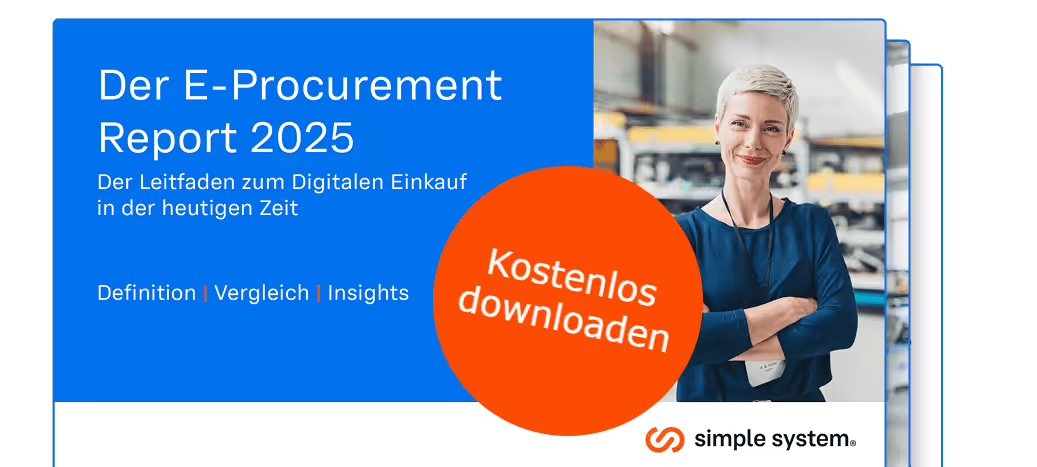Procurement 4.0 Definition: Strategic Purchasing & Procurement in Digital Transformation
Purchasing 4.0 means more than just digitization. He is changing the role of purchasing fundamental. Automation, data-driven decisions and networking make purchasing a strategic driver of innovation and competitiveness.
Digitalization is fundamentally changing purchasing. She makes him more efficient, more agile and more data-driven. Purchasing 4.0 uses cutting-edge technologies such as e-procurement, artificial intelligence (AI) and big data for purchasing processes. Through automation and the strategic orientation of procurement, companies benefit from greater transparency, optimized supply chains and an improved basis for decision-making. As a result of this change, purchasing is not only relieved operationally, but is also gaining strategic importance.
The most important things in brief
- Purchasing 4.0 is using modern technologies such as big data, AI and e-procurement systems to automate and strategically align procurement processes.
- By data-driven decisions and automation error rates and workload are reduced.
- Thanks to real-time data and digital platforms Supplier relationships are improving and potential risks in the supply chain are identified at an early stage.
- Companies remain long-term due to digital adaptability and scalability competitively.
- E-procurement systems optimize the entire value chain in a company.
Purchasing 4.0 definition
In Purchasing 4.0, the Procurement processes combined with cutting-edge technologies such as big data and AI. Thanks to digital transformation, agility, transparency and efficiency in procurement are being increased. The core tasks of Procurement 4.0 include Cost optimization, that supplier management as well as the strategic orientation based on well-founded decisions.
Purchasing 1.0 to Purchasing 4.0
The evolution of purchasing is reflected in four phases. The Purchasing 1.0 was characterized by manual processes and paper-based communication. In Purchasing 2.0 The first digitization steps have taken place. Simple e-procurement systems were brought to life. The Purchasing 3.0 On the other hand, there was advanced automation and was already increasingly based on data-based decisions. We are now at Purchasing 4.0 arrived.
Nowadays, purchasing is surrounded by AI-supported processes. In addition, processes are being completely digitized, which means that Purchasing 4.0 is increasingly becoming strategic orientation can dedicate.

Integrating AI into the purchasing process
The implementation of artificial intelligence has significantly changed purchasing processes in various areas.
- Automate routine tasks: AI performs repetitive tasks — such as auditing and managing invoices. As a result, the area of responsibility for purchasing gains time for strategic activities.
- Demand forecasting and demand planning: AI can make precise predictions of future demand by analyzing large amounts of data. This optimizes the Procurement planning and inventory management vehemently.
- Supplier evaluation and selection: AI systems continuously evaluate supplier data based on various KPIs. The consequences are data-based selection and early detection of faults.
- Data analysis and decision making: AI analyses complex data patterns. From this, it derives strategic recommendations for action, which improves decision-making.
- Optimizing price negotiations: The AI-supported negotiation assistants automate price negotiations. They analyse historical data and macroeconomic indicators and develop robust negotiation strategies.
- Proactively identify risks: Artificial intelligence usually detects disruptions and bottlenecks at an early stage by evaluating real-time data from supply chain data. Companies are given sufficient time to initiate countermeasures at an early stage.
- Real time data processing: Artificial intelligence analyses huge amounts of data in real time. As a result, the purchasing strategy enjoys improved responsiveness to market trends and supply chain disruptions.
- Supply chain optimization: Modern AI systems evaluate complex supply chain data to uncover inefficiencies and at the same time identify optimization potential. As a result, the overall performance of the procurement process is immensely improved.
Opportunities and challenges | Procurement 4.0 Definition
Purchasing 4.0 promises many possibilities, but also poses some risks and challenges:

Die modern procurement offers companies an enormous Potential to increase efficiency as well as for strategic realignment. However, digital transformation requires careful planning and continuous adaptation to changing market conditions.
The importance of big data for strategic decisions
Big data provides companies with valuable insights that go far beyond simple analyses and can significantly influence strategic decisions. By collecting and evaluating large amounts of data, companies can pattern, trends and connections recognize that would have gone unnoticed before. This enables a more precise Market forecast, identifying growth opportunities and optimizing business processes. Big data helps to make decisions based on data, which leads to greater efficiency and greater adaptability.
In the context of Purchasing 4.0, big data is defined by five key aspects:

- Amount of data (volume): The increasing amount of purchasing data from ERP systems, supplier portals and marketplaces.
- Velocity: The real-time processing of orders, demand analyses and market changes.
- Variety of data: Different data sources such as price developments, supplier evaluations and IoT sensor data from the supply chain.
- Data quality (Veracity): Ensuring reliable and consistent data for well-founded purchasing decisions.
- Value: The use of data analytics for cost optimization, risk minimization, and strategic procurement.
These five factors make it possible to data-driven, efficient and agile purchasing. Companies use customer behavior data to personalize offers and optimize the supply chain. Market analyses open up new business areas and optimize marketing strategies. In addition, big data reduces the risk of miscalculations and secures competitive advantages through well-founded decisions.

Einkaufen & sparen
Erfahren Sie, wie es geht, in unserem kostenlosen E-Procurement-Report. Jetzt kostenlos und unverbindlich herunterladen.
Jetzt lesenWhat are the benefits of Purchasing 4.0 for buyers?
Purchasing 4.0 makes the work of buyers easier. Thanks to Implementing new technologies Procurement processes are becoming immense in existing systems upgraded. As a result, the Business efficiency and strategic added value is created. Here are the key benefits of Purchasing 4.0 for buyers:
Increasing efficiency in purchasing processes

The digitization of individual areas of the company and their deployment special tools optimize The entire Procurement measures. AI-powered systems take over annoying Routine tasks. For example, order processing and checking invoices are no longer the responsibility of buyers, which significantly reduces manual work and error rates. The purchasing department gains time for strategic tasks. Also enable Real-Time Data Analytics Faster Decisions and the integrated systems improve communication between the individual departments.
Optimizing supplier management processes

Through the use of e-procurement systems supplier management processes are made more efficient. This improves collaboration. Supplier performance is based on various KPIs continuously monitored. Disruptions in the supply chain are therefore identified at an early stage.
Blockchain increases transparency in the supply chain and takes it to the next level. With the help of real-time communication, supplier relationships are improved. Digitized negotiation assistants assist with price negotiations.
Improved transparency through digital tools

Real-time data and integration of supplier information provide a clear view on stocks, delivery times and possible bottlenecks. This authorizes more precise planning. Big data analytics are an essential part of project purchasing. They provide accurate market analyses and Demand forecasts, which are then clearly presented in dashboards. Market changes? Shortages? Potential risks? A e-procurement system contains all necessary infosto adapt demand coverage to all contingencies. In this way, companies always benefit from optimal supply in their procurement processes and can react to changes.
The role of e-procurement in modern purchasing
E-procurement — or electronic procurement management — has developed in contemporary shopping established as a decisive tool. It comprises the entire digital process: from ordering to invoicing. This is changing the way companies buy their goods and services.
A clear advantage of the systems is the reduction of workload and errors. Time and cost savings are also among the notable benefits. Thanks to real-time data, collaboration with suppliers is also improved. systems such as simple system deliver user-friendly solutions that are specifically tailored to Optimizing procurement processes are aligned. They help companies to make their purchasing strategies more efficient all around and to meet current challenges.
How does purchasing remain competitive in the era of Purchasing 4.0?
In order to remain competitive in the era of Purchasing 4.0, companies must digital technologies use to optimize processes, analyze real-time data and improve collaboration with suppliers. By E-procurement, AI-powered tools, and smart technologies can purchasers React flexibly to market changes, reduce costs and increase supply chain efficiency. Digitalization promotes scalability and adaptability, which ensures that companies remain competitive in the long term.
Innovations in purchasing controlling
Real-time data analysis, AI-based forecasts, and automated reporting optimize the procurement process. Such technologies enable a precise monitoring, rapid response to changes and continuous improvement of delivery performance. You do the shopping more effective and flexible.
Connect with the supply chain
Digital networking enables seamless communication between purchasing, suppliers and logistics partners. Real-time data sharing promotes rapid responses to market changes, early risk assessment, and increased efficiency across supply chain.
synopsis
Purchasing 4.0 means more than just digitization. He is changing the role of purchasing fundamental. Automation, data-driven decisions and networking make purchasing a strategic driver of innovation and competitiveness. The use of digital solutions improves the overall value chain and actively supports you in making decisions to optimize procurement activities.
Frequently asked questions
What new skills does a buyer need in the era of Purchasing 4.0?
Procurement professionals need new qualifications for digitization in purchasing. This includes digital literacy, advanced data analysis skills, and strategic thinking.
How is Purchasing 4.0 changing the collaboration between purchasing, production and logistics?
The cooperation between purchasing, production and logistics must go hand in hand. Real-time data is used to improve coordination across the entire value chain.
What role does cybersecurity play in the digital purchasing process?
Cybersecurity protects sensitive data from attacks. It ensures secure digital processes and is an important part of e-procurement.









